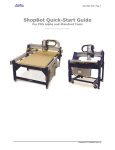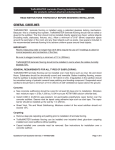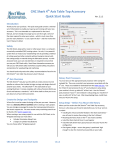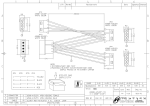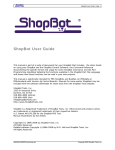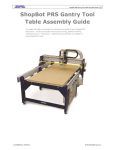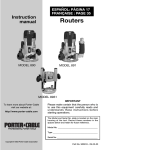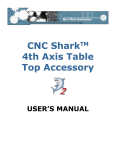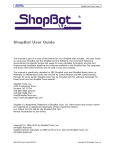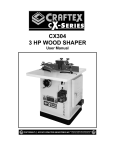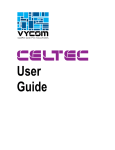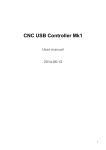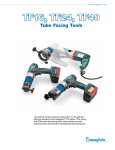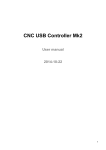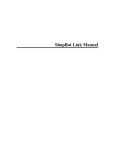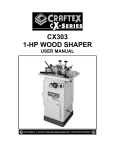Download PRS Quick-Start Guide (for PRS and Buddy tools)
Transcript
Quick-Start Guide for PRSalpha and PRSstandard tools PRS Quick-Start Guide (for PRS and Buddy tools) Introduction: This document is intended to help you get started with your new ShopBot. For more detailed information on any of these topics, please reference the ShopBot User’s Guide (www.shopbottools.com/ShopBotDocs/ gantry.htm). See also the list of resources on the back page for more information. SBG 00185 Copyright 2015 Date: 11/16/2015 Revision: 11/16/2015 Owner: M. Cummings 1 Quick-Start Guide for PRSalpha and PRSstandard tools Revision History: EC # Change Description Authority Date Release to new format, incorporating all documents updates through 7/23/15 M. Cummings 09/23/15 Updated document location, main parts picture, process flow chart, TOC pages, removed acronyms page M. Cummings 11/16/15 ShopBot Tools, Inc. 3333-B Industrial Drive Durham, NC 27704 ShopBotTools.com SBG 00185 Technical Support [email protected] (888) 680-4466 Copyright 2015 2 Quick-Start Guide for PRSalpha and PRSstandard tools Table of Contents General Safety and Precautions....................................................................................................... 5 PRS Quick-Start Process Flow .......................................................................................................... 6 Main Parts of ShopBot PRS .............................................................................................................. 7 Section 1. Software Setup and Orientation ..................................................................................... 8 Load Software and Drivers .......................................................................................................... 8 Installing ShopBot Applications .................................................................................................. 8 Installing VCarve Application ...................................................................................................... 8 Connect ShopBot to Computer ................................................................................................... 9 Load Settings File......................................................................................................................... 9 ShopBot Control Software ........................................................................................................ 10 Axis Orientation ........................................................................................................................ 11 Test Each Axis with Keypad ....................................................................................................... 12 Test the Spindle/Router ............................................................................................................ 13 Section 2: Running a Part File ........................................................................................................ 14 Zeroing the Z Axis ...................................................................................................................... 14 Z Axis Zeroing Process ............................................................................................................... 14 Zeroing the XY Axes................................................................................................................... 15 Changing Bits ............................................................................................................................. 15 Setting Up RPM Control ............................................................................................................ 16 Holding Down Material ............................................................................................................. 16 Screws .................................................................................................................................. 16 T-Track Tables and Rails ....................................................................................................... 17 Clamps .................................................................................................................................. 17 Press-Fit Jigs ......................................................................................................................... 17 Adhesive ............................................................................................................................... 17 Vacuum Hold-Down Systems ............................................................................................... 18 Holding Parts Within Material ............................................................................................. 18 Tabs ................................................................................................................................. 18 Onion Skin ....................................................................................................................... 19 Warming Up Spindle ............................................................................................................ 19 Previewing the File with Offset ............................................................................................ 19 SBG 00185 Copyright 2015 3 Quick-Start Guide for PRSalpha and PRSstandard tools Table of Contents (cont’d) Running the Cut ................................................................................................................... 20 Pausing or Stopping the Cut ................................................................................................. 20 Software Controlled Stop ................................................................................................ 20 Emergency Stop............................................................................................................... 21 Section 3: Technical Basics............................................................................................................. 22 Bits............................................................................................................................................. 22 Calculating Feed Rates and RPMs with Chip Load .................................................................... 23 Switch from Inches to Millimeters ............................................................................................ 24 Machine Maintenance ................................................................................................................... 25 Resources ....................................................................................................................................... 26 SBG 00185 Copyright 2015 4 Quick-Start Guide for PRSalpha and PRSstandard tools General Safety and Precautions: This safety summary contains general safety warnings that should be understood during operation of this machine. Failure to observe these precautions could result in injury. Learn and understand safe use of the machine. Do not allow untrained individuals to operate the machine without supervision. Be aware of the location of the Emergency Stop switches at all times. Eye and ear protection MUST be worn by the machine operator as well as any bystanders or observers. Flying sawdust, material chips, and other debris can cause serious eye injury. Wear closed-toe shoes at all times. Make sure that your material is properly secured before cutting, and be aware of any small parts that may come loose after being cut. If a small part catches the edge of a spinning bit, it can be thrown forcefully in any direction, causing injury or damage. Never place your hands on the rails of the ShopBot. Be aware that the machine may move unexpectedly in any direction, which can cause serious injury if your hands are in the path of movement. Never wear gloves while operating the machine. As with any power tool, a glove can get caught in moving or spinning parts and pull your hand into the machinery. Never leave a machine running and unattended. Understand that a spinning tool generates friction and heat, creating a risk of fire. This risk is minimized by using correct chip load (please see page 12), using sharp bits, and by always double-checking your files before cutting. Be prepared to pause or stop the cut if something seems incorrect or unsafe. Keep a working fire extinguisher within reach of the machine, for the reasons listed above. SBG 00185 Copyright 2015 5 Quick-Start Guide for PRSalpha and PRSstandard tools PRS Quick-Start Process Flow Load Software and Drivers (p. 8) Connect ShopBot to Computer (p. 9) Set RPM Control (p. 16) Test Router/ Spindle (p. 13) Zero Z Axis (p. 14) Load Settings File (p. 9) Zero X and Y Axes (p. 15) Warm Up the Spindle (p. 19) Run the Cut (p. 20) SBG 00185 Copyright 2015 6 Quick-Start Guide for PRSalpha and PRSstandard tools Main Parts of ShopBot PRS Main Parts of ShopBot Buddy SBG 00185 Copyright 2015 7 Quick-Start Guide for PRSalpha and PRSstandard tools Section 1. Software Setup and Orientation This section contains the installation of software and setting up the machine. It also explains fundamentals of the control software; including basic commands, axis orientation, and various components (motors, spindle, etc.) outside of a part file. Load software and drivers NOTE: Do not connect the ShopBot to your computer before installing the software and drivers! Special note for schools and large companies: ShopBot software runs best with full administrative permissions enabled. We strongly advise against setting up separate admin and user accounts on the control computer. For International customers: The computer used to run the machine MUST have the language set to “United States (English)” in order for the software to run correctly. Installing ShopBot applications 1. Insert USB drive into USB port in computer. 2. Double-click on folder to view files. 3. Double-click on the folder called “1 Install Controller”. Double-click on “setup_sb3_8_32” and follow the prompts for the setup wizard. Click “Finished” when completed. Installing VCarve Pro application Double-click on the folder called “2 Install Design”. Double-click on “VcarveProShopBotEdition” and follow the prompts for the setup wizard. Click “Finished” when completed. SBG 00185 Copyright 2015 8 Quick-Start Guide for PRSalpha and PRSstandard tools When installation is complete, three new icons appear on the screen: ShopBot 3, ShopBot Editor, and VCarve Pro ShopBot Edition. Connect ShopBot to computer Connect USB cable from ShopBot control box to computer. Connect the RPM controller USB from variable frequency drive (VFD) unit into another USB port on the computer. Load settings file When prompted to load a default settings file for the first time, the following screen should appear: SBG 00185 Copyright 2015 9 Quick-Start Guide for PRSalpha and PRSstandard tools Double-click on “PRS ShopBots”, and choose “Standard”, “Alpha”, or “Desktop”, depending on your model. Choose the correct table size for your machine, and this will bring you back to the main screen. Note: Custom tools will not have a default setting preprogrammed in the software. Chose the correct type (Alpha or Standard), and the size closest to your tool. Edit the table limits for your table size using “Values” and “Limits for table”. Save the new setting as a custom settings file in the “Utilities” menu. ShopBot control software The ShopBot control software works in two modes: “Easy mode” (by default) shows only the necessary functions to set up and run a cut file. “Full mode” shows all available functions and settings. Switch between the two modes by clicking on the Help/options button in the red position window. SBG 00185 Copyright 2015 10 Quick-Start Guide for PRSalpha and PRSstandard tools Axis orientation It is essential to understand how the X, Y, and Z axes are oriented, and how this relates to job setup in the CAD/CAM software. Shown below is an example of a job in VCarve Pro and its corresponding orientation on each machine model. The bottom left corner is referred to as the XY home location or “zero, zero” (See Section 3 for more information). SBG 00185 Copyright 2015 11 Quick-Start Guide for PRSalpha and PRSstandard tools Test each axis with the keypad Turn ON the control box. Click on the yellow keypad window icon within the red position window. If the icon is not visible, click “move/cut” under “Mode” on the red position window. Use the buttons on the keyboard (see below) to move the spindle/router along each axis. SBG 00185 Copyright 2015 12 Quick-Start Guide for PRSalpha and PRSstandard tools Test the spindle/router Locate the key attached to the collet wrench. Insert this key into the safety lockout next to the power switch and turn the key to “ENGAGE”. Note: Older Desktop tools do not have an interlock switch. Instead, they have an on/off switch on the underside of the VFD unit. It is illuminated red when off and green when on. Routers: Make sure that the router’s power switch is in the ON position before proceeding. In the main console window, type “K” to bring up the keypad move command. Notice that output 4 lights up in the red position window. Click output 1 to turn the output on. This will create a prompt to start the router/spindle. For PRSstandard models, press “OK” to start the router/spindle. For PRSalpha models, after toggling output 1, press the green “START” button on the three button pendant. To turn the spindle off, click the output 1 switch again or close the keypad window. All models: turn on output 1 through keypad SBG 00185 Alpha models only: press the start button Copyright 2015 13 Quick-Start Guide for PRSalpha and PRSstandard tools Section 2. Running a Part File This section covers setup procedures performed prior to previewing or running the part file. Zeroing the Z axis The Z axis must be zeroed each time that the machine is turned on or bits are changed. Zeroing can be done to either the top of the material or to the table surface. Zeroing to the top of the material is a better choice when a precise cut depth is needed (when cutting an inlay pocket, for example). Zeroing to the table surface is a better choice when throughcutting parts in wood. Because wood products naturally vary in thickness, the top surface of any given area may be higher or lower than other areas. Zeroing to the table surface will provide the most consistent through-cutting results. Whichever location is chosen, the location must be identified in the CAD/CAM program (as shown here for VCarve Pro). Failure to match what is specified in the software with what is done at the table can result in ruined material and/or broken bits! Z axis zeroing process Ensure that the software is set to Move/Cut mode. Place the grounding clip on the bit, if possible. Otherwise, place it on the collet nut or shaft of the spindle. Set the plate down directly beneath the bit. NOTE: To test the circuit before running the zeroing routine, touch the plate to the bottom of the bit. Check that input 1 lights up on the screen and goes off as soon as contact is broken. Click on the Z zero button, or type a C2 command. The Z axis will touch the plate twice and then move up to a safe height. The Z axis is now calibrated and the machine is ready to cut. Place the Z zero plate back in its holster. Remove the grounding clip from the bit and secure it safely. SBG 00185 Copyright 2015 14 Quick-Start Guide for PRSalpha and PRSstandard tools Zeroing the XY axes The best way to zero the X and Y axes is by using the proximity switch homing process. This process instructs the machine to touch off from each switch to establish a zero location, which creates an accurate and repeatable start point. Click the XY Zero button or type a C3 command to use this feature. To make a permanent adjustment to the location of your 0,0 point based on the switches, click on [T]ools > ShopBot Setup, and “Next” until you see the screen that’s marked “ShopBot setup: Prox switches.” Then click “Click here to make it easy on me.” The program will help set up the new permanent zero location. To set up a temporary zero location, simply move the spindle/router to the desired location. Write down these coordinates to ensure the exact location for later. Type a Z2 (for Zero 2 axes) command. Notice that the X and Y coordinates now read zero. This is the new 0,0 location that the cut file will reference. Changing bits Note: Spindles and routers have different collet styles. Instructions are included for both. Make sure collet and nut are completely clean. If necessary, use a wire brush, compressed air, and/or mineral spirits to remove dust or excess grease. Spindles: Before inserting the bit, press the collet into the nut and listen for the “click.” If collet does not seat, press it in at a slight angle. Confirm that the collet is snapped in by holding the nut upside-down and letting the collet hang freely. Routers: The router collet and nut are held together by a retaining clip. It is not necessary to disassemble the components for cleaning or bit changes. Spindles: snap collet into nut, then flip it over to ensure it is snapped in securely Slide bit into collet. Make sure that the collet grips only the shank of the bit, keeping any parts of the flute outside of the collet. Ideally, the bit shank should fill at least 75% of the collet. Thread collet and nut onto router or spindle. It should go on very easily. DO NOT apply force if nut is resistant. Stop and try again until it goes smoothly. Once the nut is finger-tight, check the bit again to make sure that it has not slipped. Use the included wrenches to fully tighten nut. Ensure no part of flute enters collet. SBG 00185 Copyright 2015 15 Quick-Start Guide for PRSalpha and PRSstandard tools Setting up the RPM control This section only applies to PRSstandard and PRSalpha tools equipped with a spindle. Ensure the RPM controller USB plug (from VFD unit) is connected to the computer. In the main console window (should have a pic to identify this window), click on “Tools” and then “Spindle RPM Control.” Drag the box below the position window to keep it out of the way. It must remain open at all times for the software to communicate with the VFD unit. Click on “RPM” in the left corner of the Spindle RPM box to open a settings window. Change the following parameters in the settings window: Start when SB3 Starts: Hertz: varies by country Hertz Scale: VFD 1: VFD 2: 1 60 (US, Canada, Mexico and Japan) 50 (Europe, and most other regions) Same as Hertz setting unless adjustment is required to match VFD unit and software RPM displays. Yaskawa V1000 Leave blank unless tool is equipped with two spindles. Click “OK” to save your settings. To test the function of the RPM controller, turn on the spindle and click on the listed RPM value in the spindle control window. Change it to something different and then click “Enter”. The value on the VFD unit display should match what was just entered. Holding down material Small parts can be caught by the cutter and thrown, potentially causing serious injury or damage. Therefore, it is imperative to choose the proper hold-down method for the project. It is also important to be aware of what happens to parts as they are cut from the surrounding material. Screws If a spoil board is present, the workpiece can be screwed directly to the table. This works well for most materials. However, this requires careful planning to ensure that all screws are clear of the cut path. To establish a less risky tooplpath, insert screws using the location of other toolpaths in the file. By avoiding those, you can be confident that the clearance holes are safe. A few clamps on the edge of the board will be sufficient to complete this initial run. SBG 00185 Copyright 2015 16 Quick-Start Guide for PRSalpha and PRSstandard tools T-track tables and rails A system can be set up using T-track rails (available from woodworking supply stores), inlaid into the wood table. If using this method, be sure the rails sit low enough below the surface that they are out of the way when through-cutting. Clamps There are a variety of clamps that can be used to secure material. Clamps offer secure holding power, and are ideal when there is no excess material to drive screws into. However, they usually require more planning than other methods because of the vertical clearance required. Press-fit jigs A tight press-fit jig can sometimes provide sufficient holding force. Consider using additional holddowns if cutting aggressively or using a spiral up-cut bit. Adhesive Double-sided duct tape, carpet tape, and foam tape are excellent holding options for larger projects. Because more surface area equals more holding power, this may not be a good choice for small projects. When through-cutting, make sure that the tape stays out of the cut path, as it may gum up the cutting edge, reducing cut quality. Super 77 spray adhesive is also an excellent option. However, to avoid damaging the table, bond the workpiece to a scrap board that is clean and flat, and clamp or screw this board to the table. Another option is to glue a layer of paper between the workpiece and support board. . SBG 00185 Copyright 2015 17 Quick-Start Guide for PRSalpha and PRSstandard tools Vacuum hold-down systems A well-built vacuum system is ideal for repetitive cutting of plywood and other sheet materials. ShopBot offers several kits for full-table vacuum systems on our gantry tools. Holding parts within the material Tabs Large parts may shift as they are cut free, leading to a small gouge or notch along the edge. Smaller parts can be destroyed or even thrown across the room by the cutter. There are two ways to handle this from within the software. The first option is to create tabs, or leftover “bridges” of material between the part and its surrounding area. Most CAM programs will have an automated feature for this. The feature for VCarve Pro is shown here. Adding tabs in VCarve Pro SBG 00185 Example of tabs on a part Copyright 2015 18 Quick-Start Guide for PRSalpha and PRSstandard tools Onion skin An option for tabs is to leave an “onion skin,” or very thin layer of material at the bottom of a profile cut. Set the final cut depth at slightly less than the thickness of your material (typically .010’’ - .030’’, depending on material and size). The advantage of this method is that the onion skin can be easier to trim away than a series of tabs. However, if there is a lot of variance in the thickness of your material, or if your table is not flat, then you may end up cutting too deep or too shallow and this method will not work correctly. Warming Up the Spindle Note: This step is not necessary for ShopBot machines with routers. To maximize the life of spindle bearings, warm up the spindle before cutting, after letting it sit idle for longer than 4 hours. Click on “Tools” then “Spindle RPM control” to open the spindle control window. Leaving this window open, start the spindle warm up routine (C5 command). This will run the spindle at 9000, 10000, and 12000 RPM for 3 minutes each, and will turn off the spindle when finished. Previewing a file with an offset There are several ways to perform a “test run” without actually cutting the material. First, enter Move/ Cut mode, and click on the “Cut Part” button (or “File” and “Part File Load”). Select part file, and the following screen will appear. Locate the line marked “Offset in 2D or 3D.” A 2D offset will cut the file at normal depth in a different X,Y location on the table. Once the X, Y, and Z axes are zeroed, simply move the cutter to the new location and load the part file with a 2D offset. Its current location will be used as 0,0. A 3D offset will cut at a different X, Y, and Z position. This is often referred to as “air cutting,” since it allows you to run through the file in the air above the material. To avoid cutting into the workpiece, make sure that the starting distance between the bit and the material is greater than the maximum cut depth. Click “START” or Enter on your keyboard to proceed. SBG 00185 Copyright 2015 19 Quick-Start Guide for PRSalpha and PRSstandard tools Running the cut If the test run looks good, click on “Cut Part” (or type FP command), and select part file. At the Part File (FP) setup screen (shown above), ensure “Offset in 2D or 3D” is set to “No Offset.” Click “START,” or Enter on your keyboard. You’ll see the following screen: For PRSalpha models, press the “Start” button on the three button pendant BEFORE clicking OK. For PRSstandard models, click “OK” and the router/spindle will start automatically. Pausing or stopping a cut There are two ways to stop the tool while it is moving or cutting a part file. An emergency stop cuts power to the tool and stops it the fastest. A software controlled stop, or pause, will decelerate the tool, lift the Z axis to a safe height and stop the router/spindle. Software controlled stop The gentlest way to stop the machine during a cut is to hit the space bar on your keyboard. This will bring the machine to a “soft stop,” and will retain zero locations. The soft stop is useful during nonemergency situations when adjustments or corrections are needed. Note: The “Stop” button on PRSstandard tools acts as a soft stop. For a true emergency stop twist the main stop switch on the cover of the control box. SBG 00185 Copyright 2015 20 Quick-Start Guide for PRSalpha and PRSstandard tools Emergency stop To immediately stop the spindle/router and all motors, use the red emergency stop button or switch, which will cut off power to all systems. To continue, you will need to re-zero all axes because the locations will no longer be accurate. PRSalpha models: SBG 00185 PRSstandard models: Copyright 2015 21 Quick-Start Guide for PRSalpha and PRSstandard tools Section 3. Technical Basics This section provides an overview of some basics to safely and efficiently plan your projects. This is not a comprehensive guide. More information can be found in the user’s manual, or online from the resources listed in the back of this Guide. Please be sure to review the general safety page in front of this manual before running the machine. Bits Bit material: Router bits are made from a variety of materials. The most common bits are solid carbide, carbide-tipped steel, and high-speed steel. ShopBot recommends either solid carbide or carbidetipped bits. High-speed steel bits dull quickly and must be re-sharpened often. Flute type: There are four basic flute types: Straight, spiral up-cut, spiral down-cut, and compression. Each type has its own advantages and disadvantages, which are outlined below. Good edge quality on most materials May chip or fray top face, good quality on bottom face when through-cutting Best edge quality on top face, may chip or fray bottom face when through-cutting Clean edge on both top and bottom face Moderate chip clearing abilities Excels at clearing chips and dissipating heat, especially with “o-flute” bits May compact chips in a groove Designed to cut veneered or laminated materials at full depth in one pass Upward force may cause part lifting Downward force may help with cutting thin sheets Ideal for: general-purpose Ideal for: plastics, aluminum, or cutting any material where heat buildup is a concern SBG 00185 Ideal for: plywood and laminates (pocketing) Copyright 2015 Ideal for: plywood and laminates (profile cutting) 22 Quick-Start Guide for PRSalpha and PRSstandard tools Number of flutes: The number of flutes on a bit is essential to calculating proper feed and speed rates. For most applications, a bit with 1, 2, or 3 flutes can be used, but feed rates and RPMs must be adjusted to maintain proper chip load (see below). End shape: Straight and up-spiral bits come in a variety of end shapes. Square ends are most common, and are a good choice for creating pockets and grooves, cutting profiles, simple lettering, and drilling operations. Ball (or rounded) ends are best for 3D carving. VCarve bits are often used to create complex letters for sign making. They can also be used to chamfer edges and create countersinks for screw holes. Calculating Feed Rates and RPMs with Chip Load: Chip load refers to the actual thickness of the chip cut by each revolution of the cutter. It is the measurement that all feed rates and speed calculations are based on. A spinning bit generates friction and heat as it moves through the material. Part of this heat is pulled away by the flying chips. A larger chip load pulls away more heat, but also puts more stress on the cutter. Each material has its own ideal chip load range that balances heat dissipation with cutter stress. A basic chart (in .pdf format) for common materials can be found in the SB3 software by clicking on “[T] ools”, “Chip [L]oad Calculator”, and “Chip Load Help”. Use this chart along with the Chip Load Calculator to determine a good starting speed for each toolpath. Do not rely on the tool database default settings when calculating feeds and speeds for a toolpath. Those values are only placeholders and are not intended for any particular material. SBG 00185 Copyright 2015 23 Quick-Start Guide for PRSalpha and PRSstandard tools Switch from inches to millimeters To work in metric units, click the help (blue question mark) button in the red position window, and choose the “Settings” button from the window that appears (below left). This brings up the window below right. Change the first field from inches to millimeters, and click OK at the bottom right corner of the window to save the change. SBG 00185 Copyright 2015 24 Quick-Start Guide for PRSalpha and PRSstandard tools Machine Maintenance ShopBot machines require very little maintenance, but to keep the machine running at its best, verify the following items each day: For spindles only, warm up the spindle using the spindle warm up routine (C5). Clean collet, nut, and all bits, and check for signs of wear or damage. Clean collet and nut with a brass brush and/or compressed air. Clean bits with an appropriate solvent that removes any residue or gunk. Discard dull or damaged bits. Visually inspect all wiring and hoses. Check for cuts, scrapes, or pinch points on the cables. If motor cable is damaged, DO NOT run the machine as motor and driver damage is at risk. Call ShopBot tech support (919-680-4800) for advice on how to proceed. Ensure the machine and the area around it are clean. Check for any obstructions on the rails and brush away any debris. Turn on the power. Push and pull the machine near each motor, along its axis of movement. The motors should be locked in place with no movement. Mechanical looseness in any of the axes should be corrected before proceeding. Contact ShopBot tech support (919-680-4800) for detailed instructions specific to the machine. Check the gear rack on each axis and make sure that it is clean and free of any obstructions (large chips, material scraps, etc.). For long-term maintenance instructions specific to your tool, please visit the ShopBot Docs webpage. http://www.ShopBottools.com/ShopBotDocs/maintenance.htm SBG 00185 Copyright 2015 25 Quick-Start Guide for PRSalpha and PRSstandard tools Resources To the best of our knowledge, these links are current. If you find that any of them are no longer working, please contact us so that we can update them accordingly. Detailed chip load charts: http://www.onsrud.com/plusdocs/Doc/index.html?model.code=FeedSpeeds ShopBot user’s forum: http://www.talkShopBot.com/forum Vectric training videos: http://www.vectric.com/WebSite/Vectric/support/support_vcw_tutorials.htm Additional Vectric support available within your software: click on Help > Help Contents for an interactive PDF file. 100K Garages: Post your information, bid on projects, and connect with people who want to get things made! http://www.100kgarages.com SBG 00185 Copyright 2015 26



























